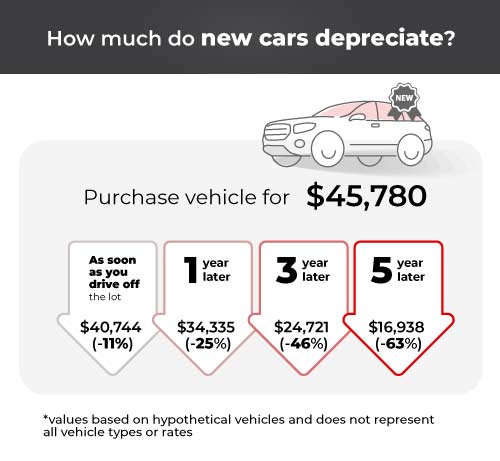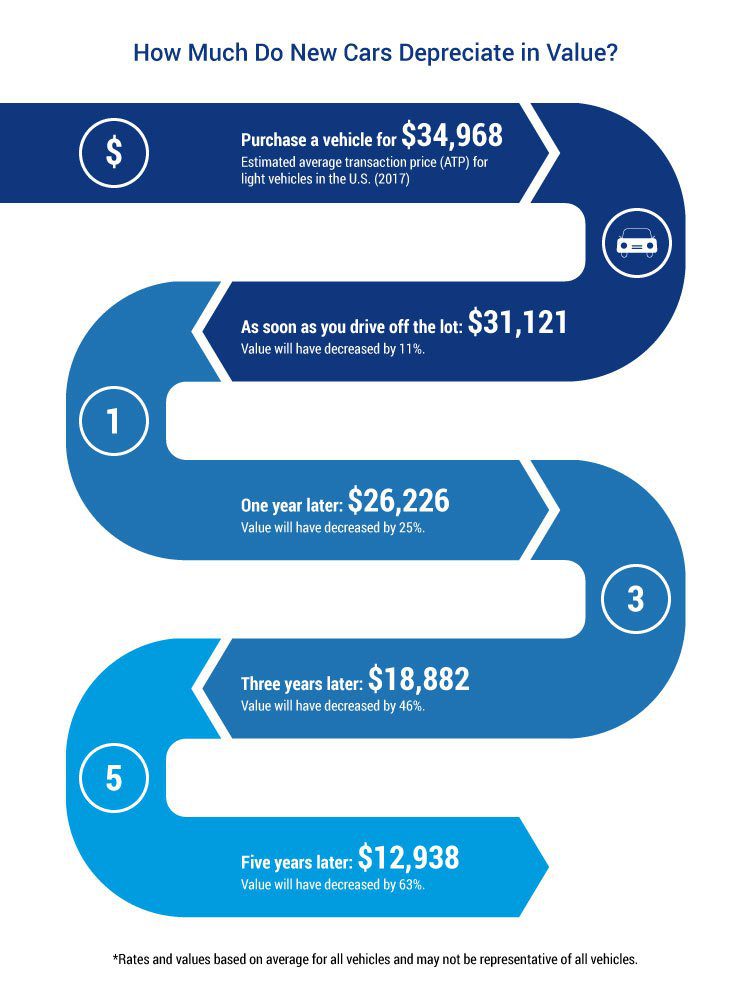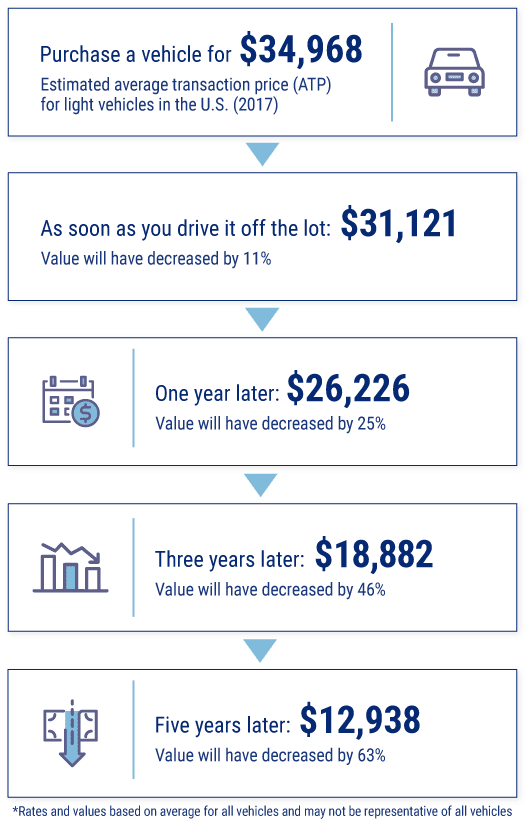How Much Does a Car Depreciate Per Year: Essential Facts
A car’s value drops each year. But by how much exactly?
On average, cars lose about 15-20% of their value each year. Understanding car depreciation is crucial for every car owner. It’s the difference between the car’s purchase price and its resale value. Many factors can affect this rate, such as the car’s make, model, and condition.
Knowing how much your car depreciates helps you make smarter financial decisions. It can guide you on when to sell or trade-in your car. This knowledge can also help you plan for future car purchases, ensuring you get the best value over time. So, let’s dive into the details of car depreciation and what you can expect each year.

Credit: www.gigacalculator.com
Introduction To Car Depreciation
Depreciation is the decrease in a car’s value over time. All cars lose value as they age. This loss starts the moment you drive off the lot. New cars can lose up to 20% of their value in the first year. By the fifth year, many cars lose about 60% of their value. This process is called depreciation.
Definition Of Depreciation
Depreciation means the drop in value over time. It is common for all cars. It happens due to wear and tear. Also, newer models coming out cause older ones to lose value. This is why cars depreciate every year.
Importance Of Understanding Depreciation
Understanding depreciation helps you make smart choices. You know how much value your car will lose. This helps in planning future purchases. It also helps in getting the best deal. Knowing depreciation can save you money.
Factors Influencing Car Depreciation
The make and model of a car greatly affect its depreciation. Popular brands tend to lose value slower. Luxury cars often depreciate quickly. Some brands hold value better than others. Choose wisely.
Mileage is key in car depreciation. Higher miles mean lower value. Cars with fewer miles hold value longer. Regular driving is okay. Avoid excessive driving to reduce depreciation.
The car’s condition plays a big role in value. Well-maintained cars depreciate less. Regular servicing is important. Fix damages promptly. Keep the interior clean. A good-looking car holds value better.
Market demand affects car depreciation too. Popular cars keep value longer. Demand can change over time. Trends matter. A car in high demand will depreciate less.
Depreciation Rates By Year
The first year is tough on a car’s value. New cars can lose up to 20% to 30% of their value. This drop can surprise many new owners. Buying used can save money here.
After the first year, the rate slows. Cars lose around 15% to 20% each year after that. By year five, a car might be worth less than half its original price. Depreciation depends on the make, model, and how well you maintain it.
Depreciation Of Different Car Types
Luxury cars lose value faster than economy cars. A luxury car may lose 15-20% in the first year. Economy cars may lose 10-15% in the first year. The gap grows each year. By year five, a luxury car may lose 60% of its value. An economy car may lose 45% of its value.
A new car loses value quickly. It can lose 20-30% in the first year. A used car loses value slower. A used car may lose 10-15% in the first year. The drop in value gets less each year. New cars face a larger initial drop. Used cars have less loss over time.
How To Calculate Car Depreciation
Depreciation is how much value a car loses over time. There are two main formulas to find this. First is the straight-line method. It is simple and used a lot. The formula is:
| Formula | Description |
|---|---|
| (Initial Cost – Salvage Value) / Useful Life | Car loses same value every year |
The second is the declining balance method. This formula is:
| Formula | Description |
|---|---|
| Initial Cost x Depreciation Rate | Car loses more value in early years |
Both formulas help understand car value loss. Choose the method that fits your needs.
Online tools can help you. Use depreciation calculators. They are easy to find. Enter car details and get results.
Car valuation websites also help. They show current car prices. Compare and see how much value your car lost.
Reading car market reports is useful too. They show trends and give insights. Stay informed about car values.
Ways To Minimize Car Depreciation
Keeping your car in good condition can slow depreciation. Regular oil changes and tire rotations help. Fix small problems quickly. Clean the car inside and out often. This keeps it looking new.
Drive fewer miles each year. Lower mileage keeps the car’s value higher. Consider walking or biking short distances. Use public transport when possible. This can save your car from extra wear and tear.
Some cars lose value faster than others. Research car models before buying. Choose cars known for holding value well. Brands with good reputation can be a wise choice. This can save you money in the long run.
Impact Of Depreciation On Car Insurance
Car depreciation significantly impacts car insurance premiums. On average, cars lose 15-20% of their value each year. This decline in value can affect your coverage and claim amounts.
Insurance Premiums
Car depreciation affects insurance premiums. As a car loses value, the insurance cost may drop. This is because the car is worth less. Insurers may charge less to cover a cheaper car. But, repairs can still be expensive. Even for an older car. This can impact the insurance rates. So, keep an eye on the car’s value. It helps to understand insurance costs.
Total Loss Claims
If a car is a total loss, depreciation matters. The payout depends on the car’s current value. A newer car gets a higher payout. An older car gets less. This is due to depreciation. Knowing the car’s value helps. It sets the right expectations for a total loss claim. It also helps in choosing the right insurance coverage.

Credit: www.thinkinsure.ca

Credit: www.crsautomotive.com
Frequently Asked Questions
How Much Does A Car Depreciate Annually?
On average, a car depreciates about 15-20% per year. This rate can vary based on make, model, and condition.
What Factors Affect Car Depreciation?
Factors include age, mileage, condition, and brand reputation. Market demand and economic conditions also play a role in depreciation rates.
How Can I Reduce Car Depreciation?
Regular maintenance, keeping mileage low, and protecting the exterior can help reduce depreciation. Choosing a car with a strong resale value also helps.
When Does A Car Depreciate The Most?
A car depreciates the most in the first three years. It can lose up to 30% of its value in the first year.
Conclusion
Understanding car depreciation helps in making better purchase decisions. Cars lose value over time. Factors include brand, model, and condition. Regular maintenance can slow down depreciation. Always research before buying. Consider resale value too. Being informed saves money in the long run.
Make wise choices and protect your investment.






